what was emotionally healthy, not just on the bottom line.
that informed his daily decisions as
In 1998, Britt graduated from Moorhead’s Concordia College, where she met
”I would say maybe your food should cost
assistant manager of the Living Forest
Nathan Kjelland, another North Dakota farm kid and the man she’d later marry. But first, more. Organic farming can pay farmers a
Cooperative (LFC) in Ashland, Wisconsin.
Britt’s mother gave her some advice.
living wage so they don’t have to rely on
Over a hundred years ago, the great
”My mom said, ’If you really feel like you need to see the world, do it now, and then subsidies, and it lets them work in a way that
northern forests fell to the ravenous
make a choice whether you want to be out in the larger world or you want to be here.’”
respects the environment.”
sounds of axes and saw blades. Mythic
So Britt moved to Boston and then Washington, D.C., for two stints in the heroes like Paul Bunyan romanticized the
AmeriCorps program, a domestic version of the Peace Corps. It was the first time she’d wholesale demolition of these mighty
lived so far from home.
hardwood forests—thousands of years in
”I really started to understand how disconnected people are from their food,”
the making. Though the razing of
Britt says. ”I had so many conversations with people about where bread comes from. I’d Wisconsin’s woodlands for quick ”boards
say, ’They harvest the wheat to make the flour’—and they would go, ’Wheat? Harvest?’ I’d and cords” profit continues in some areas,
never met anyone who didn’t know that flour came from wheat. All of that to me was the emergence of ”ecosystem foresters”
really startling.”
and the trend towards managing for
In 2002, after Nathan finished veterinary school in St. Paul, the two returned to species diversity is beginning to change
North Dakota and bought an old, yellow farmhouse on seven acres south of Valley City, the nature of the logging industry.
where they live with their five horses and two cats.
”The northern forests in our
”My mom has always been a wise woman, and I think she was right. Because it country were destroyed,” Jason says. ”They
was a choice—I didn’t feel like I had to come back,” Britt says. ”But we wanted a place were decimated. In human time it was 100
where we could have our horses. We wanted a garden. There are certain things I love to 180 years ago, but in forest time it was
about cities, but I can always go visit one.”
yesterday,” he says.
On the way back to Valley City, Britt takes Old Highway 10. On either side of the With his wife, Melissa, Jason
road, glassy lakes interrupt a sea of alfalfa.
learned what makes a healthy forest the old fashioned way, living in the backwoods.
”I know there are people in my generation who would be interested in farming if Melissa and Jason worked as wilderness rangers in the Boundary Waters Canoe Area they knew it would be profitable.” Britt says. ”Organic farming doesn’t solve all the world’s Wilderness (BWCAW) in northern Minnesota for three years. They also have bachelor’s problems, but it’s a step in the right direction.”
degrees from Carleton College. Melissa holds a master’s degree in agriculture and 92 : o u t s t a n d i n g y o u t h
u n c o m m o n w i s d o m : 93
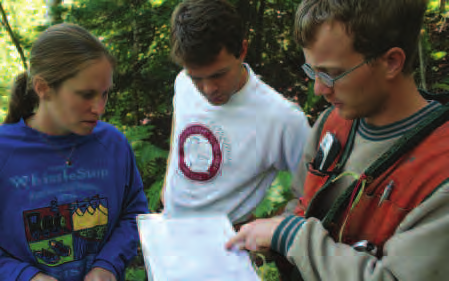
horticulture, and Jason a master’s in agronomy and plant genetics with a minor in forestry.
Jason works closely with co-op members, teaching them how to properly thin This interest in agriculture and crop production informs many of the forestry decisions trees, remove invasive species, and manage water flow and recreational use on their land.
that Jason makes, both in his small office and in the vast Wisconsin woods.
He also helps members enroll in state programs that they might otherwise not know The Living Forest Cooperative is a for-profit organization founded in 2000 by about or take advantage of.
landowners in Bayfield County to ensure better forest management. Co-op membership The Living Forest Cooperative follows the Forest Stewardship Council’s (FSC) costs a one-time $100 fee with no annual upkeep, and members share any co-op profits.
sustainable forest management criteria.The FSC only allows harvesting that closely mimics The cooperative has grown to employ three full-time staff and has around 150 members natural occurrences for that land like blow-downs, forest fires, or the felling of individual who own some fifteen thousand acres of timberland. Its goal is to manage twenty trees. By certifying landowners’ wood with FSC’s sustainable harvesting guidelines, land thousand acres so as to ensure ecosystem health, develop a regular harvesting cycle, and owners can attain higher prices as the co-op begins processing their own wood.
begin adding value to members’ wood by processing it for commercial use. Co-op Jason has always loved agriculture and has begun an innovative program to members receive a variety of benefits, including help in managing their land and encourage co-op members to plant a new breed of hazelnut shrubs on their land.
collective bargaining with loggers.
Hazelnuts are a multiuse crop that yields nuts, oil, and woody biomass, all while protecting Small landowners often lack the acreage, time, and experience to successfully watersheds and soil quality. It is an example of a new kind of crop ideally suited to today’s orchestrate a commercial timber sale. Loggers can take advantage of inexperienced agriculture because it can yield both food and fuel. Working with co-op members, Jason is landowners and may not harvest the trees the way a professional forester would developing an on-farm breeding and evaluation program. The Living Forest Cooperative recommend. The Living Forest Cooperative provides the expertise and resources necessary currently has several experimental acres of hazelnuts planted on member lands that will to help landowners develop comprehensive forest management plans, and put them into soon be mature enough to harvest. The co-op hopes to collectively market and sell the action. They negotiate logging contracts and monitor the job to guarantee essential hazelnuts, thus greatly increasing the productive value of their lands in an ecologically management goals are being achieved. ”It’s surprising how many landowners think that stable way.
they have to pay the logger to cut the trees,” Jason remarks.
Outside of Jason’s work with the co-op, the Fishbachs remain deeply involved in The co-op charges by the hour for member services. This way, the co-op can avoid their community and town planning. They form an integral part of a citizens group trying creating an incentive to over-harvest, which could result from collecting a percentage of to save the University of Wisconsin Ashland Agricultural Research Station. The citizens are harvest revenue. They usually seek to set up joint harvests where members or working to form a nonprofit organization called Chequamegon Institute (named for the nonmembers with contiguous plots decide to harvest them together, thus increasing their nearby Chequamegon Bay of Lake Superior) to resume operation of the large research profits and making value-added processing more viable. Membership in the co-op grows station for the development of innovative new agricultural, forestry, and community mainly through word of mouth, neighbors telling neighbors.
gardening practices. Several local businesses and groups have expressed interest in Jason accepts bids from all kinds of loggers for the co-op’s various harvests: from developing research projects at the station, were the University to turn over its defunct local horse loggers cutting a couple cords per day, to large commercial loggers who can facility to residents.
cut over one hundred cords a day. Everything depends on the particular planned harvest.
Melissa left her full-time job to perform a much harder and more rewarding By certifying landowner’s wood with FSC’s
By administering competitive bidding on behalf of the landowners, the co-op increases one—caring for the couple’s young son, Louis. She has found time to help form and sustainable harvesting guidelines, land
their bargaining power and helps them collect a fair price for their timber without operate a collaborative poultry business with two other young farmers. Together the three owners can attain higher prices as the co-op
sacrificing collective oversight of the project’s completion.
farmers raise, process, and direct market over 1500 chickens and 200 turkeys a year to begins processing their own wood.
For every tree that falls in a harvest, the Living Forest Cooperative plants another.
consumers in Ashland and Bayfield counties.
Last year, they planted around fifty thousand trees and are hoping to plant another Jason recently left his position with the Living Forest Cooperative to become an seventy-five thousand next year. These plantings differ from those of paper mills, which agriculture agent for Ashland and Bayfield counties through the University of Wisconsin. In usually plant only trees that have high commercial value, generating vast forests his new position, he continues his work with local ecology-based forestry and hybrid comprised of a few fast-growing species. The co-op strives for balance in its plantings, hazelnut development. He is also coordinator of the Lake Superior Eco-Apple Network, seeking to make the upcoming forest as stable and ecologically similar to presettlement helping fruit growers in the Bayfield area learn and use integrated pest management. As forests as possible. The Living Forest Cooperative uses presettlement forest cover maps—
the Fishbachs work hard to promote profitable ecological enterprises and organize for created by the University of Wisconsin from survey notes taken in the 1850s—to decide conservation, they know it will benefit not just the health and vitality of the land but also what each landowner should strive to restore.
help provide a better future for their son and future generations.
94 : o u t s t a n d i n g y o u t h
u n c o m m o n w i s d o m : 95
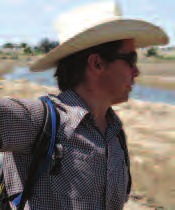

Renewing a River
oversized color master plan. By this time, summer had ended, and it was time to go back to school.
Good news came a few months later, when Dennis called to invite Fred back the next summer.The first grant that Fred had written on spring break secured them a small grant from the Bureau of Indian Affairs that included ten thousand dollars to plant several acres of trees, plus a small salary for Fred and two interns.While planting trees with the help of college students, tribal workers, and volunteers, Fred and his interns put together a three-hundred-page Colorado River restoration proposal that outlined the acquisition of permits, arizona : fred phillips
methods for dredging the river, volumes of earth to move, and numbers of trees to remove.
They also recommended building a nursery to cultivate native plants.What a consulting firm would have charged half a million dollars to prepare, they’d done for $7.50 an hour.
As a boy, Fred Phillips dreamed of riding west and becoming a cowboy.Today, he’s The proposal garnered interest, and as a result, some real money arrived. Over the a land restoration practitioner in Flagstaff, Arizona. As he points out, he didn’t miss the mark next five years, Fred and his team acquired over five million dollars in grants for the project.
by much, the two job descriptions aren’t mutually exclusive.
”Getting the money is actually the easy bit,” says Fred. ”Coming up with a plan and In 1990, Fred was a first-year landscape architecture student at Purdue University
”You know, if we can build skyscrapers and
implementing it—that’s hard.”
in Indiana. Disenchanted with school, he was searching for inspiration when a friend gave tunnels under the Chesapeake Bay, we can
What had started out as Dennis’s dream of a community park had grown into a him the telephone number of Dennis Patch, a prominent councilman with the Colorado restore the whole river. ”
project that would not only benefit the Colorado River Indian Tribes, but would also impact River Indian Tribes near Yuma, Arizona. Fred didn’t know the phone call would change his the whole river and the surrounding region. Newly energized, Fred hired local contractors life.When Dennis said he might have a summer, park design project for someone ”bored and youth to dig out three miles of river channel, remove four hundred acres of tamarisk and idealistic”,Fred packed up and drove across the country.
and revegetate with native plants, blaze four miles of trails, and build a park, boat docks and What he found was a landscape ravaged by decades of use as a dump, and an a swimming area.The dredging operations operated 24/7 for eight months carving out a ecosystem completely upended by a series of dams.The dams had led to an invasion of channel. Fred describes the work as ”hard-core, butt-kicking labor.”
exotic plants that choked out native species. Also, the changing environmental conditions Fred Phillips has found his calling. So far, his efforts have helped restore and caused by the dams had resulted in widespread deforestation of native trees. Fred learned protect over three thousand acres of degraded river corridor. Since the work with the that 90 percent of the land between the Hoover Dam and the delta had been degraded.
Colorado River Indian Tribes, he has started his own environmental consulting firm and is The Colorado River corridor supports a third of the Southwest’s plant and animal now restoring another 1400 acre project in Yuma, Arizona, and is working on projects from species.The river is considered the most threatened in the United States and almost every the Grand Canyon all the way to the Gulf of Mexico.
drop of it has been allocated and diverted. Its waters now supply irrigation for two million Fred admits that the scope of his accomplishments have exceeded his wildest agricultural acres and desperately needed municipal water to Los Angeles, Phoenix, Las expectations, and he continues to dream big. ”You know, if we can build skyscrapers and Vegas, and other desert cities. Municipal and agricultural diversion from the Colorado River tunnels under the Chesapeake Bay, we can restore the whole Colorado River,” he says.
is so rampant that water raging through the Grand Canyon will usually never make it to the
”Conservation just needs to make economic sense—then we’ll see more of it.”
ocean. At the same time, demand for water is always growing, yet climate change quickly shrinks the river’s supply from dwindling snowfall and glacial melt in the Colorado’s Rocky Mountain headwaters.
Dennis was initially hoping to build a two-acre park for the community, but soon he and Fred saw larger possibilities. Fred suggested restoring and re-vegetating a portion of the river, and offered to put a proposal together. He got hold of an old computer and cleared out a former kindergarten classroom to use as an office. Using U.S. Geological Survey maps, aerial photographs, and interviews with tribal members, Fred identified potential sites and later scouted them by hiking and camping. He found a 1200 acre site he thought showed great potential for restoration, and compiled a proposal including an 96 : o u t s t a n d i n g y o u t h
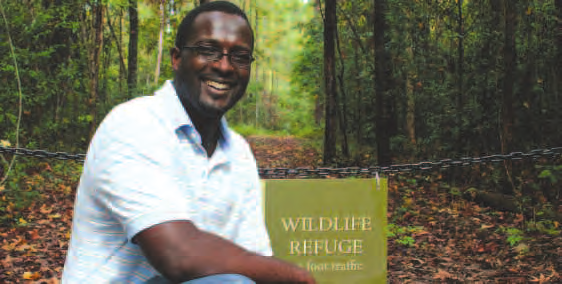
Culture and Conservation
Amadou started his proverbial walk into the woods in Senegal, where he grew up. He studied agricultural science in Tunisia, and completed his first master’s degree in animal science. After a few years back home running the family business, he went to Tuskegee University in Alabama for a second master’s, this time in agricultural and resource economics. Along the way, he’s picked up a remarkable array of languages including: Wolof, Pular, French, Spanish, Arabic, and English. If only a few of those come in handy in the rural South, his other skills, luckily, come in multiples as well.
Based in Atlanta, Georgia, Amadou works for the Federation of Southern georgia : amadou diop
Cooperatives. The Federation, born out of the civil rights movement, is a nonprofit that strives to help black and other underserved farmers stay on their land by setting up cooperatives, teaching sustainable agriculture, promoting silvopasture, setting up credit unions, assisting with marketing, and running a youth development program.
They also run a workforce development program, teaching members how to type, get a GED, build a résumé, and take online classes. The Federation has offices in four southern states and about two thousand members spanning thirteen states.
Amadou, for his part, directs the Black Belt Legacy Forestry Program.
”Much of southern land, now that no one’s left to work it, is planted fencepost-
”The aim is to be equally sustainable in
to-fencepost with cheap, short-rotation loblolly pines that get clear-cut every twenty or terms of the people, the environment, and
thirty-five years,” he explains. ”A lot of farmers are unaware of their rights, the value of economics. . . . Don’t just export your
their land, or other things they might do with it.”
wood: Keep the profit in the community.”
Farmers with small acreages, especially those who just want to thin their forests rather than clear-cut, can’t find people willing to cut their trees for a fair price. In short, brainstorming other roles for forested land has begun to look like a better and better idea. Amadou visits landowners who call the Federation requesting a consultant and works with them to develop ways to add value to their forests.
One example that shows promise in Georgia is silvopasture, or combining forestry and grazing on the same acreage—providing landowners with both short- and long-term income opportunities. While cows need grass to eat, goats thrive on the variety of undergrowth in forests. Goat manure fertilizes the trees, and their voracious appetites help keep the ground clear of underbrush, reducing the need to burn—a common practice in conventional tree farming that’s not always feasible. In Georgia and In the rural South, genuine kindness and contradictions run deep. Old-elsewhere in the South, an increasing demand for goat meat, especially in ethnic fashioned values still preside, but slowly sink into the swamps as young people flee to markets, has made this a legitimate and profitable addition to silvopasture.
the cities, looking for living-wage jobs. Change happens slower down here than it does
”The aim is to be equally sustainable in terms of the people, the in other parts, but even in the rural South, farming and land conservation are in trouble.
environment, and economics,” Amadou explains. ”Don’t just export your wood, keep Rural poverty is at a twenty-year peak, and black farm ownership has the profit in the community. Create a local industry like floor or furniture making. Get plummeted from 15 million acres at the turn of the century to less than 2.5 million acres a portable sawmill.”
today, and from over 1 million farmers to less than 18,000.
Amadou believes that even if growing longleaf pine or hardwood takes longer, But all is not bleak. ”I think things are changing,” says Amadou Diop, his lilting the benefits are multifaceted; the biodiversity and economic potential in these forests is voice optimistic. ”The KKK still has a presence in the next town over, but now they have a outstanding. He explains, ”Short rotation pine forests for pulpwood are fast, easy money, black female mayor.”
which is why many people in Georgia have chosen that option, but we’re not just 98 : o u t s t a n d i n g y o u t h
u n c o m m o n w i s d o m : 99

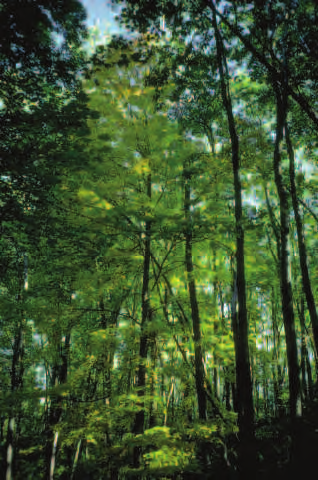
appealing to sentiment when we recommend native hardwood and longleaf pine forests for lumber instead.” They make financial sense, too. The quail, deer, and raccoon Protecting Public Lands
come back, and recreation is a growing sector, so people can offer hunting, hiking, or horseback riding on their land, another added
income possibility.
Recently, Amadou began working with the
National Wildlife Foundation in Atlanta on their
national Longleaf Pine Restoration campaign.”The
longleaf pine ecosystem is a unique working forest
wyoming : lisa dardy mcgee
where timber production, game management, and
biodiversity conservation are compatible and
mutually beneficial,” he says.
Amadou also participates in running the
youth development program, bringing ten to fifteen
local teenagers together each summer to learn about
soil, growing food, and selling at the farmers’ market.
More importantly, the program teaches young
people valuable skills: the art of running a business,
marketing, sales techniques.
”The first weekend at the farmers’ market,
they sold nothing,” says Amadou. ”They were very
upset. I said, ’Develop your social skills! Market your
produce!’We talked about it. Eventually, they sold out.”
Even though the American South is miles
away—both geographically and culturally—from
Amadou’s home in Senegal, he loves the forest, the
people, and the Federation as if he were born and
raised here.
”Rural communities still have the values that
Growing up in Ohio, Lisa Dardy McGee had always wanted to travel and see have vanished from most cities,” says Amadou. ”They
the West. ”My family wasn’t outdoorsy. I had never camped or backpacked until I was in remind me of home a little bit.”
college,” she says. ”Then, in my sophomore year, I learned about summer internships and While the Federation aims to help minority
jobs in parks and forests.”
and underserved farmers, employees like Amadou
While scooping ice cream in Grand Canyon National Park wasn’t exactly what she make their services available to everyone. ”If you’re a
envisioned, the job opened her eyes to new landscapes and potential careers. Currently small farmer in a rural community, you’re struggling
the director of the National Parks and Forests Program for the Wyoming Outdoor Council, whether you’re black or white, young or old,” Amadou
that first job now seems like a serendipitous beginning to a love affair with public lands.
points out. But in this corner of Georgia, step-by-step
Lisa went back to school after her first summer season, exploring her interests against escalating odds, Amadou Diop is working to
in art history, anthropology, and women’s studies, but her enthusiasm for public lands change that.
was cemented. Another summer would see Lisa acting as a naturalist in Yellowstone National Park at the famous geyser, Old Faithful.
100 : o u t s t a n d i n g y o u t h
u n c o m m o n w i s d o m : 101
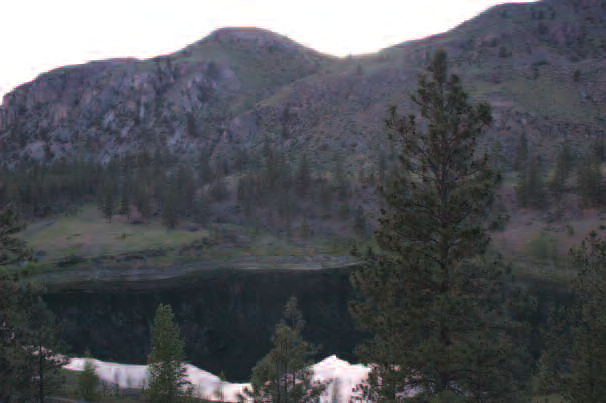
After college, Lisa became a seasonal park
get their support, as organizations like the Wyoming Outdoor Council often carry a stigma ranger in Grand Teton National Park, where she lived
with certain constituencies. ”Recently, we’ve been working with outfitters, ranchers, and for four years in the small town of Kelly,Wyoming,
hunters to help us reach our elected officials,” Lisa says.
and eventually met her husband, Matthew.The
Wyoming is a conservative state, but the town of Lander seems to embody an mountains of Wyoming were a large part of what
emerging new population. ”Lander is quite progressive for Wyoming,” says Lisa, now drew her to stay.
thirty-four. Home to several nonprofits, like the state seat of the Nature Conservancy
”I fell in love with the Tetons,” she says. ”I
and the international headquarters of the National Outdoor Leadership School (NOLS), loved living in a place where a moose in your front
the population of the area is a blend of outdoor adventure-seeking transplants, third yard was a valid excuse for being late for work.”
and fourth generation ranchers, and members of the Shoshone and Arapaho tribes on Being a federal employee had its ups and
the nearby Wind River Indian Reservation.
downs. ”I learned that the Forest Service and the
”In Lander, I feel like I’m part of a community that cares about social and National Park Service were often under pressure to
environmental issues,” Lisa says. ”But there are a lot of people, even in Lander, who disagree implement ill-conceived projects that had nothing
with the work the Council does.”
to do with protecting natural resources,” says Lisa.
Lisa manages the Wyoming Outdoor Council’s involvement with several Lisa took an internship at the Jackson
programs—all focused on federal lands. Her job can find her on a conference call Hole Conservation Alliance, working as an
about issues affecting the Greater Yellowstone ecosystem in the morning and drafting outreach assistant for the organization. In this
a response to an Environmental Impact Statement in the afternoon.
position—her first with a nonprofit—she realized
”In this line of work, the timeline by which we measure success can be vast,” she that her interest was in working with the issues
says. ”A campaign might last five to ten years and we often consider a ’win’ a retention of directly, rather than organizing events.
what we already have—in other words, keeping wild places the way they are now.”
”Within many environmental advocacy
Although seeing the ”end of the tunnel” on a given project can be a challenge, groups,” says Lisa, ”it seemed the people who dealt
the small victories along the way can be extremely gratifying for Lisa and her with the issues were lawyers or scientists. I knew I
colleagues. Just this year she filed an appeal that stopped the development of new oil needed to go back to school to be effective in an
and gas wells in the Wyoming Range—a beloved part of the Bridger-Teton National advocacy role.”
Forest south of Jackson Hole.
Back to school it was—this time for a law
Public dialogue and debate is critical to the work of the Wyoming Outdoor degree. Lisa studied public land law and natural resources law at the University of Council. ”We’ve worked closely with citizens to protect the Wyoming Range,” says Lisa.
Wyoming College of Law in Laramie. She spent a year clerking for a judge in Alaska after When she’s on the road, it’s not infrequent for her to meet with biologists and ATV
graduation. Lisa is licensed in both Alaska and Wyoming. Though she is not litigating, enthusiasts in the same day. She adds, ”We always ask ourselves how we can reach out to she says the foundation in law is indispensable to her work.
”Although there are a lot of great










